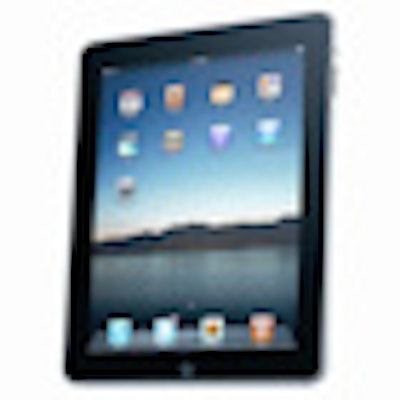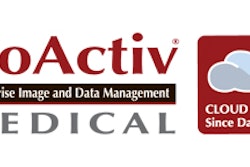
It's the mobile device that's taking the consumer electronics world by storm. But does the iPad have a role in medical imaging? Early adopters say yes -- they believe the iPad could unlock the potential of mobile computing in radiology.
The iPad has only been on the market for three months, but it has already generated significant interest and enthusiasm among radiologists and referring physicians. Efforts to define the role of the iPad in radiology are still in their early stages, but a number of researchers and vendors active in developing software applications for the iPad believe it could fulfill a role in bringing access to images and advanced visualization technology to the point of care.
Widespread utilization, however, will require addressing a number of challenges, not the least of which is security.
Packing a punch
The iPad owes its potential in radiology to its mix of size, portability, battery life, and relatively high spatial and contrast resolution, said Mark McEntee, PhD, a lecturer of diagnostic imaging at the University College Dublin School of Medicine and Medical Science in Dublin, Ireland.
The iPad's vital statistics also compare favorably to the previous mobile platform of choice, the iPhone. The iPad's 9.7-inch display provides 1024 x 768-pixel resolution at 132 pixels per inch (PPI), while the iPhone 4 has a 3.5-inch (diagonal) display with a resolution of 640 x 960, although the iPhone sports 326 PPI. The iPad weighs just 1.5 lb, much less than most conventional laptops.
The larger display allows images to be displayed at or closer to their native resolution than they would on smaller portable devices, McEntee said. The battery life of the iPad is also an advantage over the iPhone; McEntee reported using the iPad for two busy days of eight-hour use without having to recharge.
"The sleep mode is fast and responsive and uses tiny amounts of energy," McEntee said. "This is a huge advantage [over] the iPhone, whose battery finds it hard to keep up with the demands of the power-hungry display."
Clinical benefit
The iPad will likely have significantly more value within a clinical environment than the iPhone, said Mark Cain, chief technology officer of advanced visualization firm MIMvista of Cleveland.
"When you consider sitting with a patient and explaining the results of a scan, there is nothing more personal than being side-by-side, images in hand," he said. "The iPhone is the more portable choice and will be better suited for those who need access at any time, not just in the hospital."
The additional resolution on the iPad is like gold for a radiologist, Cain said.
"The amount of panning required to see a large image is significantly reduced, and that saves time," he said.
The most obvious uses for the iPad in radiology include reviewing images, reading reports, and accessing medical records, said Janice Honeyman-Buck, PhD, editor in chief of the Society for Imaging Informatics in Medicine's Journal of Digital Imaging.
In addition to the larger, high-quality screen, physicians will appreciate the speed of the iPad, Honeyman-Buck said in an e-mail to AuntMinnie.com.
"It turns on quickly, seems to open and display websites and documents faster than most laptops, and it is easy and intuitive to use," she said.
The ability to provide mobile and secure access to scheduling, patient information, historical images, and other key information without being tied down to a PC offers an opportunity for efficiency gains, said Paul Merrild, senior vice president of marketing and business development at advanced visualization and healthcare IT developer Merge Healthcare of Milwaukee.
"iPads can theoretically contain the entire electronic record of the patient's imaging experience, and can be handed along the workflow as needed," Merrild said. "At the end, the iPad has potential to provide a nice teaching and communication tool between the radiologist, referring physician, and the patient."
Radiologists could review a worklist, see overall activity within the imaging practice, view preliminary images from a technologist, or sign reports using the iPad, Merrild said. The iPad could also provide access to the Web for reference information and offer instant viewing of an electronic health record (EHR).
"This device can facilitate movement of studies as needed, communication among anyone involved in a study, and sharing of images with patients," Merrild said. "In a hospital setting, images could be given to all clinical team members at the patient's bedside. The iPad could, in essence, become a portable film jacket, but one with so much more information included."
MIMvista's Cain said that every imaging application would be compelling on the iPad.
"When you consider that the iPhone screen already makes some PACS viewers from the past look dull, the iPad is just brilliant," Cain said. "Furthermore, we think every current HIS/EMR/PACS system could have an iPad interface. It seems like it would be much more economical for hospitals to have personnel carrying iPads than hundreds of PCs taking up space in every room."
The iPad also shows promise for viewing images from PACS and viewing live procedure video, according to Tony Molinari, vice president of sales and marketing at PACS developer Foresight Imaging of Lowell, MA.
3D content
Thanks to its larger size and improved resolution, the iPad offers more potential than the iPhone for using thin-client advanced visualization software, said Vikram Simha, chief technology officer at advanced visualization firm Vital Images of Minnetonka, MN. The company has seen interest from a number of its customers in using the iPad with its 3D software.
"We see a good opportunity for bringing image/result review to the bedside with an iPad to improve communication between radiology and the referring physician," Simha told AuntMinnie.com. "It has the right form factor and resolution to bring advanced visualization to the referring physician, closer to patient care."
The iPad also offers the potential for delivering interactive, rich 3D content directly into the hands of a surgeon or other referring physicians, according to Robert Taylor, PhD, president and CEO of advanced visualization vendor TeraRecon of San Mateo, CA. The iPad's design as primarily a content viewer rather than a content production device even fits radiology's traditional workflow model.
"This 'consumption' of content created by radiology, without much ability to 'create' content directly, seems to be a great fit for the respective roles and goals of radiology and its physician customers," Taylor said.
Primary diagnosis?
But don't expect radiologists to ditch their PACS workstations and start interpreting images on iPads any time soon. The iPad would not be suitable for primary diagnosis due to its contrast ratio (maximum luminance/minimum luminance) and calibration issues, McEntee said.
For example, the iPad has a maximum luminance of 270 cd/m2, which, while higher than the average of 150-200 cd/m2 seen in off-the-shelf displays, is much lower than your average primary interpretation display, which has an average maximum luminance of 500-600 cd/m2. The iPad's minimum luminance is 0.3 cd/m2, which yields a still impressive contrast ratio of 900:1 for a portable device; the iPhone and Dell Axim v51 both have a contrast ratio of 100:1, McEntee said.
Display calibration is also an issue, McEntee said. "The iPad cannot currently be calibrated as software [and] cannot be installed in the normal way; presumably, we would 'need an app for that,' " he told AuntMinnie.com.
In addition to commercial offerings, the popular open-source OsiriX DICOM image viewer will undoubtedly make its way to the iPad, although an iPad-specific version is not yet available.
The current OsiriX version for the iPhone can be viewed on the iPad's full screen using the iPad's 2x button. However, this magnification can accentuate the resolution differences between the iPad and iPhone, leading to grainy text. "Presumably, later releases will solve this," McEntee said.
An OsiriX version for the iPad is listed as "soon available," according to a January 29, 2010, post on the OsiriX website.
Ed Heere, president and CEO of CoActiv Medical Business Solutions of Ridgefield, CT, said the company's OsiriX-integrated iPhone application can work well on the iPad as a temporary solution, providing four times the viewing size as measured in square inches as the iPhone when using the viewer's 2x button.
"The high-resolution iPad screen provides a bright, crisp image even at the enlarged size," Heere said. "Future iPad-specific apps will allow simultaneous viewing of current and prior studies as well as multiple series/image windows and much greater add-in functionality."
Other educational apps will also likely find use on the iPad, McEntee said.
Limitations
For all of its advantages, the iPad does come with some limitations to its use in radiology applications. One of the main concerns with clinical use of the iPad is the security of patient information and loss or theft of the device, McEntee said.
"To comply with HIPAA, the iPad would have to be locked with a pass key and the access to imaging should be via a Web server," McEntee said. "This should be password-authenticated and encrypted."
Also, no images should be stored on the device itself, he said.
"The locked-down nature of the hardware for the iPad means that it is very difficult to operate as a replacement for a laptop," McEntee said. "You cannot save files to the iPad; although certain apps allow a similar functionality, this seeming disadvantage makes it more secure from an imaging perspective. If lost, you can be assured that -- provided the previous user logged out -- there are no patient data on the iPad."
Hospital IT departments will have to work on the logistics of ensuring secure access to data, according to Honeyman-Buck. "These devices cannot be left lying around where another person could access protected patient information," she said.
The tablet PC's larger size can also be a detriment. Because it won't fit in a pocket, it will need some sort of shoulder-strap cover that doesn't impede the physician's easy access to the screen, Honeyman-Buck said.
In contrast to the more mobile form factor provided by the iPhone, the iPad would probably take the place of a patient chart -- kept in a slot on a bed or a wall, and picked up by various different users when access to enterprise data is needed, TeraRecon's Taylor said.
"So, the iPad will need some software changes to find a niche in healthcare, because it will need to be a locked-down, tightly controlled IT asset accessible safely by multiple users -- in that regard, it's not there yet," Taylor said.
The weight of the iPad can make it difficult to carry around and use, Foresight's Molinari said. In addition, it suffers from connectivity issues (such as no USB support).
And institutions need to be aware of more than just the physical security of the iPad. A virtual private network (VPN) will be required to use the iPad for secure, HIPAA-compliant remote viewing of images, CoActiv's Heere said.
"Perhaps future Apple [operating system] versions and future apps will allow the use of SSL connectivity like on our PC platforms, eliminating the need for VPN tunnels," Heere said.
FDA impact
Also yet to be determined is the impact on the iPad of the U.S. Food and Drug Administration's (FDA) decision earlier this year to classify MIMvista's Mobile MIM iPhone image viewing software as a class III device requiring premarket approval (PMA). If the FDA's decision stands, it could hamstring the development of commercial image review apps by requiring software developers to go through the time-consuming PMA process.
Indeed, MIMvista's Cain believes that the FDA's logic in regulating iPhone software would also apply to the iPad.
"The iPad makes portable image viewing significantly more usable and practical, which seems to challenge the claim that it is not a medical device," he said.
Merge's Merrild said that his company believes there will not be issues with the FDA regarding radiology workflow tasks such as scheduling, insurance verification, billing, and report viewing.
"Even with very limited image viewing capabilities -- without the presence of measurement tools or advanced features such as [multiplanar reformatting] or angle measurements -- this will likely be acceptable to regulators and users," Merrild said.
In the meantime, innovation in terms of mobile image review will definitely be limited until the FDA or other authorities in other jurisdictions provide a clear ruling on the use of these devices as part of a diagnostic toolset, Merrild said.
"We have confidence that these regulatory issues will eventually be resolved," Merrild said. "We believe the larger issue facing patient safety in radiology currently is the use of open-source [non-FDA approved] software on workstations."
CoActiv's Heere believes the initial and somewhat undefined position of the FDA on the use of mobile devices in radiology will ultimately be resolved in favor of a "patient care" approach.
"A strict interpretation of some of the current information would suggest that even the use of laptop or notebook computers would require a PMA for use in radiology," Heere said. "This would create a real problem for the hundreds of thousands of current users of these existing mobile devices. Until a formal published position is released by the FDA, we stand by our original position that the iPhone and iPad use of any of our products is strictly for review purposes and not for any diagnostic or interpretive use."
By Erik L. Ridley
AuntMinnie.com staff writer
June 24, 2010
Image courtesy of Apple.
Related Reading
FDA action may rain on iPhone's medical imaging parade, March 23, 2010
Handheld devices show promise in emergency radiology, January 21, 2010
CT scans sent to iPhone can make appendicitis diagnoses, December 2, 2009
Medical apps on iPhone demonstrate value, potential, November 30, 2009
Handheld devices show promise for patient education, June 8, 2009
Copyright © 2010 AuntMinnie.com




















